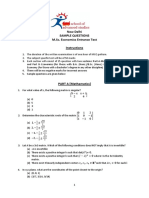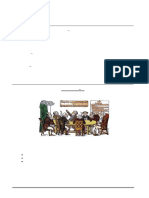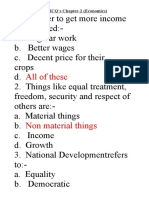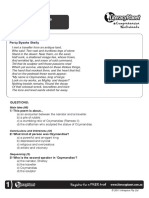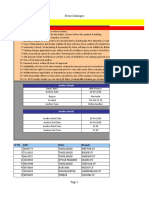Questions - Homework - 10th - Social Studies - 2021-11-26T13 - 03
Questions - Homework - 10th - Social Studies - 2021-11-26T13 - 03
Uploaded by
Nisha SinghCopyright:
Available Formats
Questions - Homework - 10th - Social Studies - 2021-11-26T13 - 03
Questions - Homework - 10th - Social Studies - 2021-11-26T13 - 03
Uploaded by
Nisha SinghOriginal Title
Copyright
Available Formats
Share this document
Did you find this document useful?
Is this content inappropriate?
Copyright:
Available Formats
Questions - Homework - 10th - Social Studies - 2021-11-26T13 - 03
Questions - Homework - 10th - Social Studies - 2021-11-26T13 - 03
Uploaded by
Nisha SinghCopyright:
Available Formats
Homework
Social Studies - 10th
Q (1): Development goals of different sections of our society can be achieved by
(a) forc
e
(b) democratic political process
(c) violent agitation
(d) terroris
m
Q (2): Find the incorrect option regarding the statement given below. The development
goal of an urban unemployed youth may be
(a) having a self owned home to live in
(b) having a permanent white collar job
(c) not having to face social discrimination
(d) having more opportunities for job
Q (3): Money cannot buy all the goods and services that we may need to have a good
life. A list of things required for a good life is given below. Which among the following
are things money cannot buy?
i ) Full protection from infectious diseases
(ii) High quality education
(ii) A luxury home
(iv) A polution-free atmosphere in every part of the country
(a) (i) and (ii) (b) (ii) and (iii)
(c) (i), (ii)and (iii) (d) (i) and (iv)
Q (4): In World Development Reports, brought out by the World Bank, which criterion is
used in classifying countries?
(a) total income
(b) gross income
(c) per capita income
(d) net income
Q (5): Pick out the correct meaning listed below to define 'average income'.
(a) Average income of the country means the total income of the country
(b) The average income in a country isthe income of only employed people.
(c) the average income is the same as per capita income
(d) The average income includes the value of property held.
Q (6): In a small village there four families with an average income of rupees 10000 if the
income of the three families is Rs.14000 , Rs.8,000 and Rs. 9,000. then, what is
the income of the fourth family?
(a) 7500 (b) 13,000
(c) 10,000 (d) 9,000
Q (7): In a country, a vegetable seller has income of Rs.5000 but an IT professional in
the same country has a salary of Rs.1,25,000. The average income of the country is
Rs. 68,000. What does it show?
(a) income disparities
(b) high per capita income
(c) the country is rich
(d) total income is more suitable for comparison
Want to access 7 lac+ questions?
powered by Get MCQs based on latest CBSE pattern & auto-check the
homework
the homework app
Homework
Q (8): Find the incorrect option
(a) Per Capita Income (PCI) gives a better comparison between countries.
(b) it is also called final income
(c) PCI is calculated by dividing total income of country (GDP) by its total population
(d) World Bank publishes World Development Report every year to compare the nations on
the basis on Per Capita Income.
Q (9): Which one of the following is not a feature of developing country?
(a) agriculture as the major occupation
(b) high technological development
(c) disguised unemployment
(d) mass poverty
Q (10): Small children in a remote Village have to travel 5km every day to attend this
school as there is no school in their area. They have to go out at 6 a.m. in the
morning in winters it becomes even more difficult as there are no street lights
even. What can be said about the situation
(a) there is unequal income distribution
(b) there is no sustainable development
(c) there is less per capita income
(d) there is lack of public facilities
Q (11): The total number of children of age group 14 and 15 years attending school as a
percentage of total number of children in the same age group is referred as
.......................
(a) human development index
(b) literacy rate
(c) net attendance ratio
(d) per capita income
Q (12):
Study table and answer type questions that follow. which state has the highest
literacy rate?
(a) Kerala (b) Bihar
(c) Haryana (d) . none of these
Q (13): The number of deaths of children less than one year of age per 1000 live births is
referred as.....................
(a) net attendance ratio
(b) infant mortality rate
(c) life expectancy at birth
(d) gross national income
Want to access 7 lac+ questions?
powered by Get MCQs based on latest CBSE pattern & auto-check the
homework
the homework app
Homework
Q (14): Select the option which is incorrect to say that Human Development Report
depends upon the following criteria.
(a) living standard
(b) health status
(c) religious background
(d) educational level of the people
Q (15): An adult whose Body Mass Index is more than 30 will be classified as
(a) underweight (b) overweight
(c) normal (d) obese
Q (16): Assertion (A) Different people having different developmental goals.
Reason (R) People want freedom, equality, security and respect.
(a) Both A and R are true and R is the correct explanation of A.
(b) Both A and R are true, but R is not the correct explanation of A.
(c) A is true, but R is false.
(d) A is false, but R is true
Q (17): Assertion (A) A high average income is not indicative of the overall well-being of a
country
Reason (R) Average income does not cover human development indicators like level of
education, health and public facilities.
(a) Both A and R are true and R is the correct explanation of A.
(b) Both A and R are true, but R is not the correct explanation of A.
(c) A is true, but R is false.
(d) A is false, but R is true
Q (18): Assertion (A) A country at present has very high national income due to surplus
oil resource. However it is essential how to look for alternative sources of income also.
Reason (R) Oil is a natural resource that is non-renewable in nature. if it is not used
judiciously then it will get exhausted soon.
(a) Both A and R are true and R is the correct explanation of A.
(b) Both A and R are true, but R is not the correct explanation of A.
(c) A is true, but R is false.
(d) A is false, but R is true
Q (19): Which of the following activity belongs to the tertiary sector of the economy?
(a) Fishing (b) Farming
(c) Factory work (d) Teaching
Q (20): Sunil, son of a farmer after studying in Agricultural University, has become a
research scientist and undertakes work for developing hybrid oil seeds. Analyse
the information to know the sector in which he has shifted from past to present.
(a) From tertiary to primary
(b) From secondary to primary
(c) From primary to tertiary
(d) From primary to secondary
Q (21): Arrange the following in the correct sequence.
(i) Transporting cloth to the workshops (Tertiary)
(ii) Sale in shops and showrooms (Tertiary)
(iii) Spinning the yarn (Secondary)
(iv) Growing of cotton (Secondary)
(a) i-iv-iii- (b) iv-iii-i-
Want to access 7 lac+ questions?
powered by Get MCQs based on latest CBSE pattern & auto-check the
homework
the homework app
Homework
ii ii
(c) iv-i-ii- (d) iii-iv-ii-
iii i
Q (22): As the methods of farming changed and the agriculture sector began to prosper,
most of the goods produced were _______ from the primary sector and most
people were also employed in this sector?
(a) Synthetic products
(b) Involved machines
(c) Natural products
(d) Mixed products
Q (23): The activities in the primary, secondary and tertiary sector of the economy are
_______ with each other.
(a) Independent (b) Related
(c) Interdependent (d) Associated
Q (24): Madhav has no regular employment. Sometimes he earns very little with some
part time work. He also has no investment capability to use own skills to earn money.
In which sector Madhav is engaged?
(a) Tertiary and organised sector
(b) Primary and public sector
(c) Secondary and organised sector
(d) Tertiary and unorganised sector
Q (25):
The above table gives the GDP in rupees (crores) by the three sectors:
From 2000 to 2013, which sector of the economy showed the maximum growth in terms
of the share of each sector in the GDP of the country.
(a) Primary sector
(b) Secondary sector
(c) Tertiary sector
(d) All of the above
Q (26): A flower cultivator grows tulips, reaps a good crop and sells it to a trader. The
trader exports the tulips and earns huge profit. This increased the GDP but the
farmer is still not able to earn well. Why?
(a) Most of the profit is taken by trader.
(b) Farmer is under employed or disguised employed.
(c) Farmers, traders, exporters work in unorganised sector.
(d) All of the above
Q (27): Arrange in sequence.
1. Making of Khoya
2. Buying of sweets during diwali
3. Extraction of milk
4. Displaying sweets in showcase
(a) 4, 1, 3, 2 (b) 3, 1, 4, 2
(c) 1, 2, 4, 3 (d) 2, 3, 1, 4
Q (28): GDP stands for Gross Domestic Product. What does it show? Pick up the correct
statement given below:
(a) It shows the economy of a country in a given year in terms of its total output.
(b) It shows the total product of a country in a given year without counting the country's total
Want to access 7 lac+ questions?
powered by Get MCQs based on latest CBSE pattern & auto-check the
homework
the homework app
Homework
resources.
(c) It shows the number of people involved in production in a particular year.
(d) It shows the total value of trade transactions of a country in a particular year.
Q (29): Consider the following statements about GDP of a country.
(i) Purchase of sugarcane in the making of sugar.
(ii) Value of silk fabrics for sale in the market.
(iii) Final value of bakery items.
Which of the following statements should be added to find out GDP?
(a) Only (i) and (ii)
(b) Only (i) and (iii)
(c) Only (ii) and (iii)
(d) None as all are intermediate goods
Q (30): Underemployment is hidden in contrast to someone who does not have a job and
is clearly visible as unemployed. It is also called _______
(a) Hidden employment
(b) Disguised unemployment
(c) Unstable employment
(d) Less employment
Q (31): How do big private companies contribute in the development of a nation?
(a) By increasing the demands for their products through advertisements.
(b) By increasing their profits.
(c) By increasing productivity of the country in the manufacturing of industrial goods.
(d) By providing private hospital facilities for the rich.
Q (32): Choose one correct statement from the following. Underemployment occurs
(a) When people are not willing to work.
(b) When people are working slowly.
(c) When people are working less than what they are capable of doing.
(d) When people are not paid for their jobs.
Q (33): Which one of the following is a private sector industry?
(a) BHEL (b) TISCO
(c) OIL (d) SAIL
Q (34): Read the statements and choose the correct option.
Assertion (A): Repair persons and daily wage earners are not very productive in tertiary
sector.
Reason (R): Repair persons and daily wage earners are unskilled, therefore they are
mostly unemployed on a short-term basis.
(a) Both A and R are true and R is the correct explanation of A
(b) Both A and R are true, but R is not the correct explanation of A
(c) A is true, but R is false
(d) A is false, but R is true
Q (35): Read the statements and choose the correct option.
Assertion (A): Not every good or service that is produced and sold needs to be counted
to know the total production in each sector.
Reason (R): The value of final goods already includes the value of all the intermediate
goods.
(a) Both A and R are true and R is the correct explanation of A
(b) Both A and R are true, but R is not the correct explanation of A
Want to access 7 lac+ questions?
powered by Get MCQs based on latest CBSE pattern & auto-check the
homework
the homework app
Homework
(c) A is true, but R is false
(d) A is false, but R is true
Q (36): Read the statements and choose the correct option.
Assertion (A): The Government of India buys wheat and rice from farmers at fair price.
Reason (R): Public sector contributes to the economic development.
(a) Both A and R are true and R is the correct explanation of A
(b) Both A and R are true, but R is not the correct explanation of A
(c) A is true, but R is false
(d) A is false, but R is true
Want to access 7 lac+ questions?
powered by Get MCQs based on latest CBSE pattern & auto-check the
homework
the homework app
You might also like
- Crochet Your Own Kawaii Animal Cuties Includes 12 Adorable Patterns and Materials To Make A Shiba Puppy and Sloth (Katalin Galusz)Document66 pagesCrochet Your Own Kawaii Animal Cuties Includes 12 Adorable Patterns and Materials To Make A Shiba Puppy and Sloth (Katalin Galusz)Mythili SHIVKUMAR100% (10)
- CFP Certification Exam Practice Question Workbook: 1,000 Comprehensive Practice Questions (2019 Edition)From EverandCFP Certification Exam Practice Question Workbook: 1,000 Comprehensive Practice Questions (2019 Edition)Rating: 5 out of 5 stars5/5 (1)
- Holidays Homework Class-10 S.STDocument10 pagesHolidays Homework Class-10 S.STsnawar150No ratings yet
- MCQs For Understanding Economic DevelopmentDocument16 pagesMCQs For Understanding Economic Developmentrajini.mvpk3No ratings yet
- Social Studies VvvipDocument11 pagesSocial Studies Vvvipyogeswara rao paidiNo ratings yet
- Screenshot 2023-05-04 at 9.59.41 AMDocument18 pagesScreenshot 2023-05-04 at 9.59.41 AMrohirakrishna8No ratings yet
- Development MCQDocument4 pagesDevelopment MCQa.adhithya.1307No ratings yet
- QP - Class X - Social-Science - Practice Paper-1Document6 pagesQP - Class X - Social-Science - Practice Paper-1moondragonsrage0% (1)
- People As ResourceDocument5 pagesPeople As ResourceSocialscience4u.blogspot.com100% (1)
- SQP-2 EconomicsDocument6 pagesSQP-2 EconomicsAsha BhardwajNo ratings yet
- Assign DeveopmentDocument3 pagesAssign Deveopmentkuldeepnishad62No ratings yet
- Best Higher Secondary School Economics Class Test Marks 50 Time 45 MinDocument4 pagesBest Higher Secondary School Economics Class Test Marks 50 Time 45 Minapi-232747878No ratings yet
- Economics WS Ch-1 Class 10Document3 pagesEconomics WS Ch-1 Class 10Apoorv SahuNo ratings yet
- IED CH 7Document32 pagesIED CH 7Puja BhardwajNo ratings yet
- Economics 2Document2 pagesEconomics 2gahlotvansh11No ratings yet
- Class 10 Social (Economic) CH 1 QUESTIONSDocument19 pagesClass 10 Social (Economic) CH 1 QUESTIONSKSA TEXTILENo ratings yet
- Test DevelopmentDocument9 pagesTest DevelopmentMR BeastNo ratings yet
- 10 - CBSE - Economics - Class Notes - Bb5a15aDocument5 pages10 - CBSE - Economics - Class Notes - Bb5a15aAvadhoot OakNo ratings yet
- Periodic Test 2 Eco Class-12Document4 pagesPeriodic Test 2 Eco Class-12amandeep malikNo ratings yet
- Economics Sample Paper 5 CBSE Pattern 2024-25 (Indian Publishers)Document17 pagesEconomics Sample Paper 5 CBSE Pattern 2024-25 (Indian Publishers)rggdu1546No ratings yet
- CUET 2024 Economics Mock 01Document15 pagesCUET 2024 Economics Mock 01Dhruv SharmaNo ratings yet
- ECONOMIC AND SOCIAL DEVELOPMENT (Questions Only)Document16 pagesECONOMIC AND SOCIAL DEVELOPMENT (Questions Only)RavenNo ratings yet
- ECO 10th Eco Ch. 1 - Solution-1Document13 pagesECO 10th Eco Ch. 1 - Solution-1ankitsins26No ratings yet
- Development AssignmentDocument6 pagesDevelopment Assignmentshashank03012010No ratings yet
- Class 10 Social Science MCQs Chapter 1 DevelopmentDocument11 pagesClass 10 Social Science MCQs Chapter 1 DevelopmentParveen KumarNo ratings yet
- Cuet Ug Economics MCQsDocument8 pagesCuet Ug Economics MCQsvijayakumarmundaNo ratings yet
- Unit 1 Multiple Choice EconomicDocument8 pagesUnit 1 Multiple Choice Economicsolearun10% (1)
- Manipur High Court LDA in English (April)Document535 pagesManipur High Court LDA in English (April)Premson Singh SamomNo ratings yet
- 25 - Answersheet Worksheet 3eco DevelopmentDocument9 pages25 - Answersheet Worksheet 3eco Developmentpratyush.cisaNo ratings yet
- Home Economics Mcqs PaperDocument27 pagesHome Economics Mcqs Paperlog manNo ratings yet
- Social Science Class X Sample Paper Test 05 For Board Exam 2024Document6 pagesSocial Science Class X Sample Paper Test 05 For Board Exam 2024yashaskengeriNo ratings yet
- CH-1 Development MCQDocument6 pagesCH-1 Development MCQmridul.bNo ratings yet
- Eco Test SamplePaperDocument6 pagesEco Test SamplePaperSadaf TalmizNo ratings yet
- Economics - (Class-10th) Objective Type Questions - 093112Document17 pagesEconomics - (Class-10th) Objective Type Questions - 093112PranavNo ratings yet
- Microeconomics: Sample Multiple-Choice QuestionsDocument6 pagesMicroeconomics: Sample Multiple-Choice Questionskunalshah81No ratings yet
- DevelopmentDocument5 pagesDevelopmentSocialscience4u.blogspot.comNo ratings yet
- Class 10th Social Science Sample Paper-1 QuestionDocument8 pagesClass 10th Social Science Sample Paper-1 QuestionmughispatelNo ratings yet
- Economics, GeographyDocument51 pagesEconomics, Geographyshuvanita2006dasNo ratings yet
- Board Practice Paper 5Document11 pagesBoard Practice Paper 5vivin2410che09No ratings yet
- Class.X. Development (Eco)Document3 pagesClass.X. Development (Eco)iams4sahilNo ratings yet
- XII Eco Quarterly ExamDocument12 pagesXII Eco Quarterly ExamAshreyaNo ratings yet
- Kendriya Vidyalaya Sangthan, Ahmedabad Region Study Material For The Session 2020-21 Class X Multiple Choice and Descriptive Type QuestionsDocument53 pagesKendriya Vidyalaya Sangthan, Ahmedabad Region Study Material For The Session 2020-21 Class X Multiple Choice and Descriptive Type QuestionsAnajNo ratings yet
- Board Practice Paper 7Document11 pagesBoard Practice Paper 7vivin2410che09No ratings yet
- Economics..Ch1... Mcqs and Assertion and Reasons....Document8 pagesEconomics..Ch1... Mcqs and Assertion and Reasons....parthsharma20092No ratings yet
- 12 EconomicsDocument4 pages12 Economics2408dhruvNo ratings yet
- Sample Paper 2 Economics Class 12thDocument13 pagesSample Paper 2 Economics Class 12thmathurusha39No ratings yet
- SST Exclusive Sample PaperDocument8 pagesSST Exclusive Sample PaperbadasserytechNo ratings yet
- People As A Resource MCQsDocument1 pagePeople As A Resource MCQsABNo ratings yet
- ECONOMICSDocument6 pagesECONOMICSsomoyeenoch33No ratings yet
- CCL Accounts Clerk Exam in EnglishDocument331 pagesCCL Accounts Clerk Exam in EnglishlundwalabulletrajNo ratings yet
- Development: 1. Objective QuestionsDocument3 pagesDevelopment: 1. Objective Questionshariom sharma0% (1)
- MCQ Economics 2Document15 pagesMCQ Economics 2Abhinav GuliaNo ratings yet
- Social Science Class 10Document6 pagesSocial Science Class 10sankalptiwari9091No ratings yet
- MCQ Worksheet Ch.1 EconomicsDocument2 pagesMCQ Worksheet Ch.1 EconomicsAarnav AryaNo ratings yet
- APPSC Group 2 Prelims in EnglishDocument320 pagesAPPSC Group 2 Prelims in Englishbobbyshilton73No ratings yet
- RRB Junior Engineer Stage 1Document327 pagesRRB Junior Engineer Stage 1Tuhin MondalNo ratings yet
- MCQs of EconomicsDocument90 pagesMCQs of Economicssumatijain132No ratings yet
- Stock Exchanges World WideDocument24 pagesStock Exchanges World WidebangarumayuriNo ratings yet
- Anish Sir - Economics Menti 1Document5 pagesAnish Sir - Economics Menti 1T KamalNo ratings yet
- Going Viral: COVID-19 and the Accelerated Transformation of Jobs in Latin America and the CaribbeanFrom EverandGoing Viral: COVID-19 and the Accelerated Transformation of Jobs in Latin America and the CaribbeanNo ratings yet
- Russian RevolutionDocument26 pagesRussian RevolutionNisha SinghNo ratings yet
- Money and Credit AakashDocument4 pagesMoney and Credit AakashNisha SinghNo ratings yet
- Ozymandias: Year Level: Year 8/9 GenreDocument3 pagesOzymandias: Year Level: Year 8/9 GenreNisha SinghNo ratings yet
- Dhruv Tuition Classes Class-IX Test Science Ch-Work and EnergyDocument2 pagesDhruv Tuition Classes Class-IX Test Science Ch-Work and EnergyNisha SinghNo ratings yet
- Questions - Homework - 10th - Science - 2021-11-21T08 - 31Document6 pagesQuestions - Homework - 10th - Science - 2021-11-21T08 - 31Nisha SinghNo ratings yet
- Comprehensive Test Series IX Chapter: Triangle and Lines and AnglesDocument1 pageComprehensive Test Series IX Chapter: Triangle and Lines and AnglesNisha SinghNo ratings yet
- Questions - Homework - 10th - Social Studies - 2021-11-27T13 - 03Document4 pagesQuestions - Homework - 10th - Social Studies - 2021-11-27T13 - 03Nisha SinghNo ratings yet
- Dhruv Tuition Classes: Subject-Science Class-VIDocument2 pagesDhruv Tuition Classes: Subject-Science Class-VINisha SinghNo ratings yet
- CBSE Class 7 Geography WorksheetDocument2 pagesCBSE Class 7 Geography WorksheetNisha SinghNo ratings yet
- Dhruv Tuition Classes Class-X Science Term-1 Sample Paper 2Document13 pagesDhruv Tuition Classes Class-X Science Term-1 Sample Paper 2Nisha SinghNo ratings yet
- CBSE Class 7 History WorksheetDocument1 pageCBSE Class 7 History WorksheetNisha Singh33% (3)
- One Day: RevisionDocument12 pagesOne Day: RevisionNisha SinghNo ratings yet
- Answers - Homework - 10th - English - 2021-11-25T10 - 57Document7 pagesAnswers - Homework - 10th - English - 2021-11-25T10 - 57Nisha SinghNo ratings yet
- Is Matter Around Us PureDocument24 pagesIs Matter Around Us PureNisha SinghNo ratings yet
- Chemical Effects of Electric Current Worksheet - 1 Class 8: Multiple Choice QuestionDocument5 pagesChemical Effects of Electric Current Worksheet - 1 Class 8: Multiple Choice QuestionNisha SinghNo ratings yet
- 1macroeconomics IDocument65 pages1macroeconomics IAYUSHI PATELNo ratings yet
- 1st Sem Result of BBA (B&I) Exam Held in Feb 2023Document33 pages1st Sem Result of BBA (B&I) Exam Held in Feb 2023HardikNo ratings yet
- AGREEMENT - Investment - ValcorzaDocument2 pagesAGREEMENT - Investment - ValcorzaJEPH Manliguez EnteriaNo ratings yet
- OxfordELLT Listening Sample 1 Questions May24Document3 pagesOxfordELLT Listening Sample 1 Questions May24Nehemie SawadogoNo ratings yet
- HdbpanindiaDocument95 pagesHdbpanindiaatul4uNo ratings yet
- PillingDocument8 pagesPillingRafiul IslamNo ratings yet
- Performance Management Systems and Practices of Deloitte Performance Management Systems and Practices of DeloitteDocument7 pagesPerformance Management Systems and Practices of Deloitte Performance Management Systems and Practices of DeloitteNilesh Kumar GuptaNo ratings yet
- Consultancy Financial Offer TemplateDocument2 pagesConsultancy Financial Offer TemplateteemehmudNo ratings yet
- LX3015DHT+3000W+Au3tech 3723+Quotation+LXSHOW LASERDocument24 pagesLX3015DHT+3000W+Au3tech 3723+Quotation+LXSHOW LASERseba.gando.mirNo ratings yet
- pp04Document16 pagespp04Ilya YasnorinaNo ratings yet
- 5) OEE Measuring PerformanceDocument34 pages5) OEE Measuring PerformanceM. Munir FahmiNo ratings yet
- Dambii Lak 234 Bara 2015Document26 pagesDambii Lak 234 Bara 2015Raajii BaraaNo ratings yet
- Book Summary - From 6 To 7 Figures 2Document13 pagesBook Summary - From 6 To 7 Figures 2baltazar.francisco0728No ratings yet
- Worksheet-5 Measurement of National Income - MacroeconomicsDocument2 pagesWorksheet-5 Measurement of National Income - MacroeconomicsBoda TanviNo ratings yet
- Econ 201 Tutorial 1 2023Document2 pagesEcon 201 Tutorial 1 2023NomveloNo ratings yet
- Fs SerpentineDocument8 pagesFs SerpentineVirgínia GomesNo ratings yet
- Adcorp 3Document9 pagesAdcorp 3rtchuidjangnanaNo ratings yet
- Partnership Operation - ProblemDocument1 pagePartnership Operation - ProblemIñego Begdorf100% (2)
- Kuni Sitari6Document10 pagesKuni Sitari6Sisca GustianiNo ratings yet
- ICare January 2023 Application FormDocument2 pagesICare January 2023 Application Formeugene CortezNo ratings yet
- Item in Voice DownloadDocument1 pageItem in Voice DownloadMokshada YadavNo ratings yet
- 12 Endogeneity, Instrumental Variables, Two Stage Least Squares, Treatment EffectsDocument70 pages12 Endogeneity, Instrumental Variables, Two Stage Least Squares, Treatment EffectsahportillaNo ratings yet
- Ledger 3Document2 pagesLedger 3nilkanthj2297No ratings yet
- Condition of Rental Property Checklist: InstructionsDocument4 pagesCondition of Rental Property Checklist: InstructionsDoug BellNo ratings yet
- 2-11 ANOVA Analysis of VarianceDocument81 pages2-11 ANOVA Analysis of Varianceankit7588No ratings yet
- Log BookDocument4 pagesLog Bookmanojsingh474No ratings yet
- Giw MegaDocument2 pagesGiw MegaEduardo PNo ratings yet
- Nason Bothello AMR2023 Far From Void How Institutions Shape Growth in Informal EconomiesDocument19 pagesNason Bothello AMR2023 Far From Void How Institutions Shape Growth in Informal EconomiesYouness AgNo ratings yet
- 2018 Industry Overview: Direct Retail SalesDocument2 pages2018 Industry Overview: Direct Retail SalesradinstiNo ratings yet
































